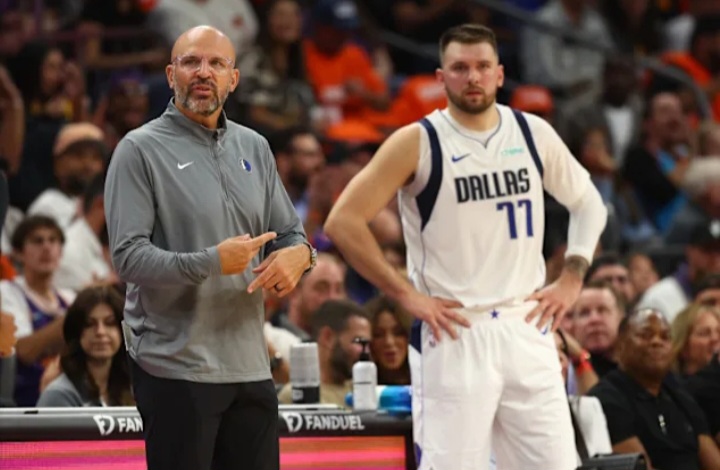Klay Thompson was arguably the biggest free agent fish the Dallas Mavericks ever landed when he joined the team last Offseason. Touted as the Mavs’ top priority (granted that was only shortly after Derrick Jones, Jr. was touted as the same), there was heavy interest from both sides to form a union. Thompson believed he could be the missing piece to a Mavericks championship, saying “I was watching just as a basketball fan, and I did see, like, ‘Man, I could really help this team. They’re right there.”
Thompson saw what just about anyone else could see. He would absolutely feast on open three-point shots when playing next to the gravity both Luka Doncic and Kyrie Irving command. Then the unthinkable happened and Luka Doncic was traded. Following shortly thereafter, Kyrie Irving was lost for the remainder of the season and beyond. Most people thought Thompson would suffer the most from the loss of those two players, but the reality may surprise you.
On April 21st we ran a Buyer’s Remorse article which led to a discussion in the comments section. Special shoutout to Mavs Moneyball community members PadrePirate and Doc1977, who prompted this further look into Thompson’s season by way of that discussion.
Thompson logged 72 Regular Season games with Dallas. 26 of those games were played on or before Christmas Day (Doncic’s last game with the Mavs) and 46 were played thereafter. In other words, nearly two-thirds of Thompson’s Regular Season games came without Doncic on the roster. Another important consideration is that Thompson theoretically had more opportunity, purely on the basis of how many other players were injured, later in the season when things got really bad (the stretch where the Mavs could barely field 8 players). With those thoughts in mind, we’ll have a look at how the numbers shook out. The entire month of December will count as part of the “Doncic Era” for simplicity sake.
The Doncic Era
October (5 games) / November (12 games) / December (11 games; 9 with Doncic)
PPG: October – 15.6 / November – 12.3 / December – 15.4
3FG%: 38.8% – October / 35.6% – November / 40.0% – December
FG%: October – 43.8% / November – 35.9% / December – 47.0%
The Post-Doncic Era
January (14 games) / February (10 games) / March (15 games) / April (5 games)
PPG: January – 13.1 / February – 15.1 / March – 15.4 / April – 9.2
3FG%: January – 43.3% / February – 41.8% / March – 35.3% / April – 40.0%.
FG%: January – 42.4% / February – 41.8% / March – 38.9% / April – 42.5%
Analysis
PPG: Thompson was very consistent month-to-month throughout the season. Excluding April (we’ll come back to that), he ranged from 12.3 PPG to 15.6 PPG. Interestingly, both came during the Doncic Era.
April was an anomaly. Although he played in the same number of games (5) in both April and October, the actual playing time was vastly different. In October, the least minutes per game he logged was 26:05. In April, the most minutes per game was 29:09. He also had an April game where he played only 12:31.
3FG%: Thompson had his worst shooting from three in the month of March (35.3%), but that effectively washed with the slightly better month of November (35.6%). Other than that, Thompson hit at or above 40.0% in the Post-Doncic Era, with a blazing 43.3% in 14 January games.
FG%: Thompson’s overall shooting percentage was the best by far in the month of December (47.0%), but this followed the worst month by far in November (35.9%). As a result, the overall averages in the Doncic Era and Post-Doncic Era are not that dissimilar.
Looking beyond the slash-lines, there are of course many other statistics of note across the season. Let’s have a look at a few more.
Thompson had a number of potent shooting nights from beyond the arc. There were five games where he attempted at least 9 threes while converting over 55% of them. Those performances include games he went 7-for-11, 6-for-10, 7-for12 and 5-for-9 (twice). Three came in the Doncic Era and two came in the Post-Doncic Era.
Thompson had six games scoring 25 or more points. He scored 25 (twice), 26 (twice), 28 and 29 points. One came in the Doncic Era and five came in the Post-Doncic Era. While this is arguably the most lopsided of all the views we’ve taken thus far, it should be remembered that Thompson inevitably got more looks later in the season when the injury bug hit the team hardest.
Finally, Thompson played five games where he logged 34 or more minutes. Everyone of those games came after Doncic was off the roster. Interesting not-so-fun fact: the Mavericks only got a single win in those five games.
For a player considered by many to be susceptible to injury and likely to fall off with the absence of Doncic, Thompson proved to be a reliable presence and a consistent one at that. This entire analysis stemmed from a previous comments-section discussion, so we of course invite you to chime in and offer up any points that were not covered here.

